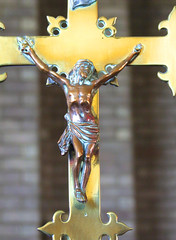| |
|
Here we are in Bramford Lane in
west Ipswich, just beside the railway bridge, and this
little church is tucked away behind its car park as if it
were a school or a municipal office. The undistinguished
brick and flint exterior conceals a famous architect, and
an outstanding, devotional interior. Cachemaille Day's
only major work in Suffolk maintains an Anglo-catholic
presence in the largely non-conformist west side of town.
Around it, the Victorian terraces and 1930s semis are
anonymously urban; but St Thomas has a curious
Scandanavian edge to its otherwise Suffolk perpendicular
shape. One often finds this hint in the late 1930s. The
Second World War seems to have brought it to an end.
The interior is a
surprise. It is of great character and beauty.
The white vaulted ceiling, the narrow lancet
lights above the long altar, the wide aisles with
their Stations of the Cross, all conspire to
create a sense of being part of a larger
building, perhaps in the crypt of a great
cathedral. The week after my first visit I was at
Sacré-Cœur in Paris, and instantly
recognised that this church would be quite at
home as one of the underground chapels there.
St Thomas is, of course, quite different in style
to its almost exact contemporary across town, All
Hallows. There, Cautley used Art Deco to fit a
similarly inspired version of Suffolk
Perpendicular. Like All Hallows, St Thomas
contains one medieval survival; this is the bell
from the disused church at Knettishall, up on the
Norfolk border.
But perhaps Art Deco was already old, and this
was the coming thing. Think of the contemporary
Norwich City Hall, in a quite unashamedly
Scandinavian style. St Thomas' clean lines and
open spaces speak of this, and perhaps a
teensiest hint of the Romanesque was also on
Cachemaille Day's agenda. All in all the parish
should be extremely proud of this gorgeous little
jewel. |
|
 |
|
|
|

